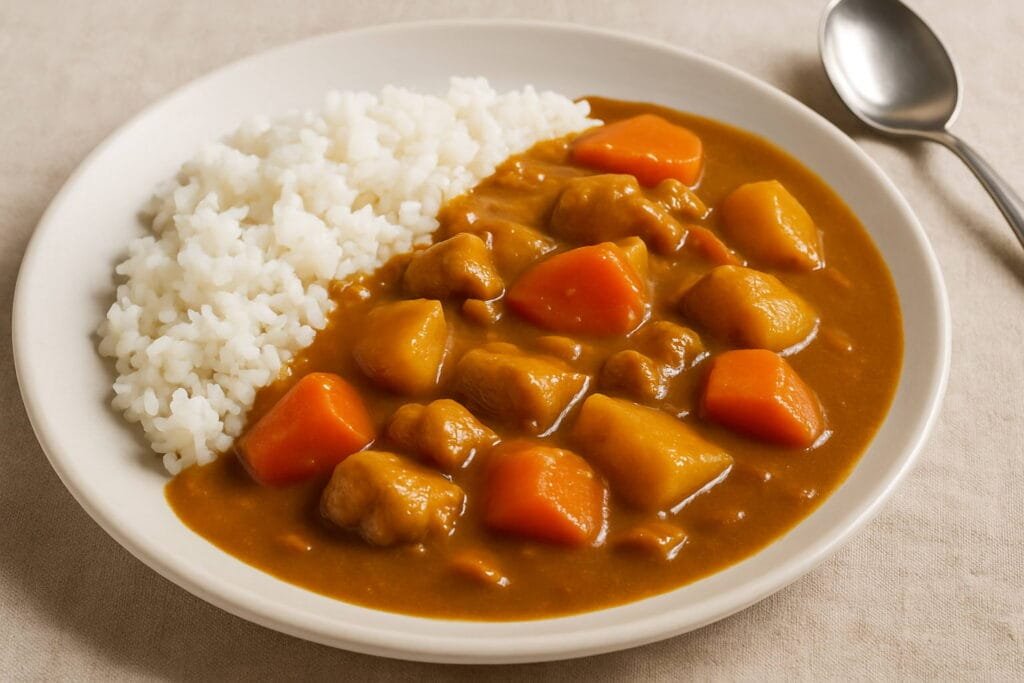The kare raisu It is one of the most popular and comforting homemade dishes in modern Japanese cuisine. Its origin dates back to the Meiji period, when Japan adopted Western culinary elements—especially from the United Kingdom, which had adapted Indian curry to its own style. Over time, kare raisu evolved into a unique recipe deeply rooted in everyday Japanese culture.
This dish features a thick and smooth sauce made with spices, combined with meat (like chicken, pork, or beef), potatoes, carrots, and onions. It's served over Japanese white rice, making a complete and flavorful meal that's loved by both kids and adults. It's such a common part of everyday life that it's served in schools, military bases, restaurants, and homes alike.
What makes kare raisu especially appealing is its versatility: it can easily be adapted to each family's taste, with additional ingredients like grated apple, Worcestershire sauce, or even spicy touches. It's also a great way to incorporate vegetables and proteins into one simple and delicious dish.
Although its preparation is relatively easy, kare raisu carries an emotional weight in many Japanese families, as it is considered a “mom’s dish” that evokes childhood memories and a sense of home. Today, it remains a symbol of Japanese home cooking, loved for its comforting flavor, practicality, and history.
Health Benefits of Kare Raisu

The Kare Raisu (kare raisu) is much more than a comforting and tasty dish: it can also offer various health benefits when prepared in a balanced and homemade way. Its combination of proteins, carbohydrates, vegetables, and spices makes it a complete option, ideal for those seeking a nutritious diet without sacrificing flavor.
One of the main benefits of Japanese curry lies in its content of fiber-rich vegetables such as carrots and potatoes, which support digestion, help regulate intestinal transit, and provide essential vitamins like A and C. Additionally, by incorporating lean sources of protein such as chicken, this dish contributes to the maintenance of muscle mass and promotes a feeling of fullness that can help control appetite.
Curry itself, made with a blend of spices like turmeric, cumin, ginger, and coriander, has antioxidant and anti-inflammatory properties. In particular, turmeric contains curcumin, a compound that has been studied for its potential to reduce chronic inflammation, improve brain function, and even strengthen the immune system.
On the other hand, if prepared with brown rice instead of white, Japanese curry can become an even more nutritious meal, as it increases the intake of fiber, minerals, and B-complex vitamins. This version improves glycemic control and cardiovascular health.
Although some commercial versions of Japanese curry may be high in sodium or saturated fats, choosing a homemade preparation allows you to control the quality and quantity of the ingredients, resulting in a healthier dish.
In summary, Japanese curry with rice is an example of how traditional cuisine can combine flavor, culture, and nutrition in a single dish. When prepared with care and balance, it not only nourishes the body but also supports overall well-being.
Kare raisu is not just a recipe, but a reflection of how Japan has skillfully adapted foreign ingredients and made them an essential part of its culinary identity. Preparing it at home is a simple way to enjoy a dish full of history, flavor, and warmth. Whether shared at a family meal or as a comforting option on a cold day, this Japanese classic proves that simplicity can be deeply delicious. Give it a try and discover why it’s a favorite in millions of Japanese homes.
Maybe you might like: Essential Tips for a Healthy Diet



